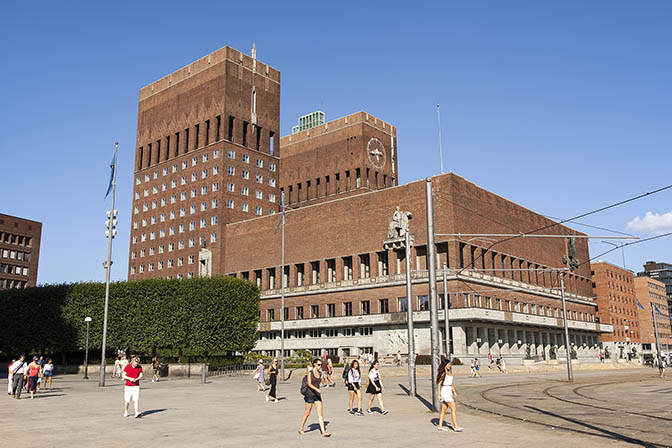Oslo's most iconic building stands away from Karl Johans Gate. It is The townhouse, that is the city hall. Throughout the centuries of its existence, the city did not manage to create a real town hall.

In old Christian (the name of Oslo in the years 1624-1925) private houses had to serve as the seat of the municipal authorities. Only at the beginning of the 20th century. Hieronymus Heyerdahl, former mayor of the city, decided to raise money for the construction of the town hall. Construction work dragged on forever. Eventually, the building was erected in 1950 r. and was opened on the 900th anniversary of Oslo. The controversial project of Arneberg and Poulsson still arouses mixed feelings among the inhabitants of the capital. Straight, geometric form with its dignity attracts the attention of people arriving in the city. On one of the town hall towers there is a characteristic one, huge clock, whose chime plays a tune every fifteen minutes. Many outstanding Norwegian artists contributed to the creation of the interior of the building (for example Edward Munch). The spacious rooms are decorated with tasteful frescoes of Norwegian landscapes, historical figures and scenes from the Jewish people. The impressive size of the Representative Hall is especially worth seeing (Radhusballen), decorated with oil paintings by Henryk Sorensen. It is here that the Nobel Peace Prize is awarded every year.
Medal for peace.
Every year 10 On December, the Nobel Peace Prize is awarded at the Oslo City Hall. The award is granted from 1301 r. It enjoys special prestige among other peace awards. A special medal made for this occasion, designed by the Norwegian sculptor Gustav Adolf Vigeland, it is made of pure gold. It bears a likeness of the founder and originator of the award – Alfred Nobel
The oldest part of Oslo is the old city with over 1000 years. Its heart is Akershus Fortress. Located on a hill, at the end of Olsofjorden, it was supposed to protect the city from invaders from the sea. Its construction began in 1299 r. krol Hakon V Magnusson. Do XVDI w. the fortress was modernized and rebuilt many times. Then it also received its final shape. Today, it serves as a museum and a venue for many state celebrations. Oslo's great tourist attraction is the Museum of Contemporary Art. Most of the Norwegian works of art created after World War II can be seen here, in the former building of the Norwegian Bank. The exhibitions include works by artists from all over the world.
A reminder of the ice age.
Oslo was destroyed by fires again and again. When in a year 1624 the fire consumed almost the entire capital, King Christian IV decided to break the fate and build a completely new city under the name of Christiania. Akershus built a large area at the foot of the fortress, known today as Kvadraturen (Quadrangle). This name is related to the symmetrical distribution of perpendicular streets. You can find old market squares here, museums and traditional eateries.
